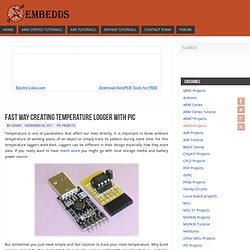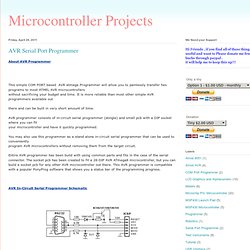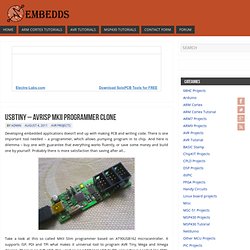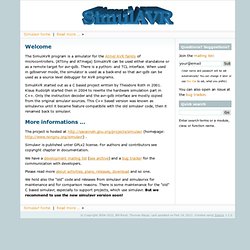

How to configure Eclipse for the Stellaris Launchpad. Fast way creating temperature logger with PIC. Temperature is one of parameters that affect our lives directly.

It is important to know ambient temperature of working place, of an object or simply track its pattern during some time. For this temperature loggers work best. Loggers can be different in their design especially how they store data. If you really want to have stand alone you might go with local storage media and battery power source. But sometimes you just need simple and fast solution to track your room temperature. Read. USBasp – USB programmer for Atmel AVR controllers. Microcontroller Projects: AVR Serial Port Programmer. About AVR Programmer This simple COM PORT based AVR atmega Programmer will allow you to painlessly transfer hex programs to most ATMEL AVR microcontrollers without sacrificing your budget and time.

It is more reliable than most other simple AVR programmers available out there and can be built in very short amount of time. AVR programmer consists of in-circuit serial programmer (dongle) and small pcb with a DIP socket where you can fit your microcontroller and have it quickly programmed. You may also use this programmer as a stand alone in-circuit serial programmer that can be used to conveniently program AVR microcontrollers without removing them from the target circuit. Entire AVR programmer has been build with using common parts and fits in the case of the serial connector. AVR In-Circuit Serial Programmer Schematic Ensures that the chip is receiving exactly +5V voltage it ensures error free programming. Pony Prog :The Programming software !! Click on "Yes" button to confirm the programming. Products - Atmel AVR 8- and 32-bit Microcontrollers - 32-bit AVR UC3 - Atmel AVR Studio 5.0.
USBTiny – AVRISP MKII programmer clone. Developing embedded applications doesn’t end up with making PCB and writing code.

There is one important tool needed – a programmer, which allows pumping program in to chip. And here is dilemma – buy one with guarantee that everything works fluently, or save some money and build one by yourself. Probably there is more satisfaction than saving after all… Take a look at this so called MKII Slim programmer based on AT90USB162 microcontroller. It supports ISP, PDI and TPI what makes it universal tool to program AVR Tiny, Mega and Xmega devices. Read. Overview — Simulavr homepage. The SimulAVR program is a simulator for the Atmel AVR family of microcontrollers.

(ATtiny and ATmega) SimulAVR can be used either standalone or as a remote target for avr-gdb. There is a python- and TCL interface. When used in gdbserver mode, the simulator is used as a back-end so that avr-gdb can be used as a source level debugger for AVR programs. SimulAVR started out as a C based project written by Theodore Roth in 2001. Klaus Rudolph started then in 2004 to rewrite the hardware simulation part in C++. The project is hosted at (homepage: . Simulavr is published unter GPLv2 license. We have a development mailing list (see archive) and a bug tracker for the communication with developers. Please read more about activities, plans, releases, download and so one. » ATtiny45/85 Servo Library Cunning Turtle. Recently I worked on a project where I wanted to control a servo using an ATtiny85.

I checked online for ready made code that did this but I couldn’t find anything satisfactory. Not wanting to switch to a larger microcontroller I decided to write my own servo library for the ATtiny85. I call it Servo8Bit. It supports up to 5 servos, runs on the ATtiny85 or ATtiny45 and uses only one 8 bit counter. It can generate a servo control pulse from 512 to 2560 microseconds with 256 steps of resolution. I enjoy using ATtiny microprocessors in my projects, particular the ATtiny85. This library is modeled after then Arduino servo library and has an identical interface.
The definition of the delay() function is omitted, which is needed to for this code to compile. Functions overview These are the functions that are available in this library. Ladder Logic for PIC and AVR. (also in: Italiano, Deutsch, Português, Русский) Quick summary: I wrote a compiler that starts with a ladder diagram and generates native PIC16 or AVR code. Features include: digital inputs and outputs timers (TON, TOF, RTO) counters (CTU, CTD, `circular counters' for use like a sequencer) analog inputs, analog (PWM) outputs integer variables and arithmetic instructions easy-to-use serial communications, to a PC, LCD, or other device shift registers, look-up tables EEPROM variables, whose values are not forgotten when you lose power simulator, to test your program before you generate PIC/AVR code.
Programming the ATTiny85, Arduino Style. This is a sort of a continuation of the last post.

In the last post, I showed how to load the ATTiny85 cores into the Arduino IDE. If that worked for you, cool! This how to actually program the chip. If it didn't work... put a comment somewhere. I'll try to help. What this circuit does is connect the ATTiny to power and ground, but it also has four wires for communication. The breadboard programmer above isn't the only way making a target board. It is is the same circuit as the breadboard, only more permanent. Actually Programming the Chip Once you have one of these target boards, either on a breadboard or perfboard (or something else), we can actually program it. So connect your target board, make sure everything is connected, and (IMPORTANT!) That should do it. If another set of text appeared, something is wrong.